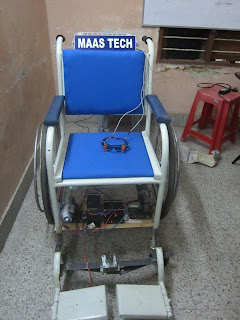ELECTRICAL
PROJECTS ABSTRACT
Wind-Solar
Energy -hybrid power generation System
INTRODUCTION
Renewable energy is energy that comes from resources which are continually
replenished such as sunlight, wind, rain, tides, waves and geothermal heat. About 16% of
global final energy consumption comes from renewable
resources, with 10% of all energy from traditional biomass, mainly used for heating, and 3.4% from hydroelectricity. New renewables
(small hydro, modern biomass, wind, solar, geothermal, and biofuels) accounted
for another 3% and are growing very rapidly.[1] The share of
renewables in electricity
generation is around 19%, with 16% of electricity coming from
hydroelectricity and 3% from new renewables.
Wind power
Airflows can be used to run wind turbines. Modern
utility-scale wind turbines range from around 600 kW to 5 MW of rated
power, although turbines with rated output of 1.5–3 MW have become the most
common for commercial use; the power available from the wind is a function of
the cube of the wind speed, so as wind speed increases, power output increases
dramatically up to the maximum output for the particular turbine. Areas where winds
are stronger and more constant, such as offshore and high altitude sites, are preferred locations for
wind farms. Typical capacity factors are 20-40%, with
values at the upper end of the range in particularly favourable sites.
Solar energy
Solar energy applies energy from the sun in the form of solar radiation for heat or to
generate electricity. Solar powered electricity
generation uses either photovoltaics or heat engines (concentrated solar
power). A partial list of other solar applications includes
space heating and cooling through solar architecture, daylighting, solar hot water, solar cooking, and high
temperature process heat for industrial purposes.
Solar technologies are broadly characterized as either
passive solar or active solar depending on the way they capture, convert and
distribute solar energy. Active solar techniques include the use of
photovoltaic panels and solar thermal collectors to harness the energy. Passive
solar techniques include orienting a building to the Sun, selecting materials
with favorable thermal mass or light dispersing properties, and designing
spaces that naturally circulate air.
Growing concerns of global warming, volatility of oil
price, vanishing fossil fuels, and energy security have increased the public
interest in clean and sustainable energy
resources. Residential generation systems harnessing wind
and solar energy are
seen as a potential answer to individual energy concerns.
The demonstration system consists of a 3W PV array mounted
on the roof of the building and a 18W wind turbine on a handmade monopole tower
installed near the building as shown in Figure 1. The system is named “WISE” to
imply the benefits of combining wind and solar energy resources for residential
electric generation.
It also contains a microcontroller to check the generated
voltages and availability of power and switches the circuit accordingly to take
power from the system continuously.
The project model block diagram is given below
Block Diagram
IEEE PROJECT ABSTRACT 2013-WIRELESS EYEBALL WHEELCHAIR PROJECTS FOR PARALYSED PATIENTS
EMBEDDED
PROJECTS-CHENNAI/IEEE PROJECTS-WIRELESS Eye ball Sensor for automatic Wheel
Chair for paralysed patients
This Wireless intellichair is
designed to help the paralysed person who moves on a wheel chair, instead of
the handicapped person moves the wheel chair by his hand, the chair will
automatically move to a particular direction as the patient moves his eyes
towards a direction, with the help of Eye ball movement detection sensor. The
chair will also sense the obstacles in front of it and gives a beep sound. The details regarding the construction of
this chair includes the following
Model:
A prototype model
which symbolizes the wheel chair is constructed using the MS Sheet (WHEELCHAIR BATTERY OPERATED- USING DC
MOTOR
12V/60 RPM-1AMPS CURRENT RATINGS)
Pic Microcontroller Board:
This is the board which contains PIC
Microcontroller Chip as well as the clock Circuitry, Reset Circuit and Power
Supply for the Microcontroller.
Power supply:
Provides
Power Supply for the IC’s and components
RF Transmitter:
A wireless RF 433 MHZ transmitter is
used to convert the digital signals from the encoder to Wireless RF Signals and
transmit the data
RF Receiver:
A wireless RF 433 MHZ Receiver is
used to convert the Wireless RF Signals to digital signals and sends it to the
microcontroller
Intruder Sensor

EYEBALL WHEELCHAIR-SOLAR OPERATED REAL WHEELCHAIR
 www.maastechindia.com
www.maastechindia.com
SOLAR SYSTEMS BASED EYEBALL SENSING REAL TIME WHWEELCHAIR

EYEBALL WHEELCHAIR-SOLAR OPERATED REAL WHEELCHAIR
 www.maastechindia.com
www.maastechindia.comSOLAR SYSTEMS BASED EYEBALL SENSING REAL TIME WHWEELCHAIR
An Infrared sensor is used as a
intruder detector. So when an intruder
is sensed we can redirect the movement of the Model.
Eye ball Movement Sensor:
This is used to
sense the movement of the eye ball’s direction and converts it into digital data
and transfers it to the Master controller. (Straight Command, Left/Right
Command, Stop Command)







No comments:
Post a Comment